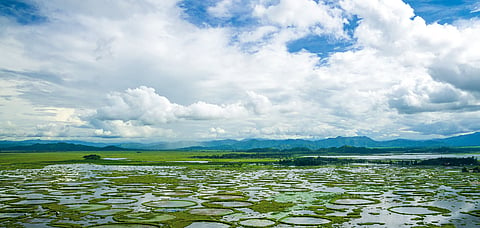
- Destinations
- Experiences
- Stay
- What's new
- Editor’s Picks
- Responsible Tourism
- CampaignsCampaigns
- Subscribe

Northeast India&rsquos largest freshwater lake, with its extraordinary archipelago of floating green islands, is the most striking sight you will see from the air while flying into Manipur. Technically, these aren&rsquot regular &lsquoislands,&rsquo but floating biomass with rich nutrients for plant growth, locally known as &lsquophumdis&rsquo.
Considered a lifeline for the people inhabiting the surrounding areas, Loktak Lake and its countless phumdis support not just birds and rich aquatic life, but also thousands of fishermen, who have developed an entire way of life on these floating islands, navigating through them on narrow boats, easily turning landmasses into waterways whenever needed, to negotiate their way through them.
Likewise, they have also learnt to ingeniously join phumdis together to create fishing coves in the middle of the lake, and again dismantle them to create different shapes whenever needed. Sailing through the phumdis of Loktak with a fisherman, you will find that all the lines&mdashbetween land and water, transient and permanent, stable and wobbly&mdashare negotiable, an oddly refreshing sensation. The distinctive topography and ecosystem here have shaped a man-nature interaction that&rsquos as exceptional as the landscape itself.
Among Loktak&rsquos many phumdis is Keibul Lamjao National Park, the world&rsquos only floating national park, and the last natural refuge of the critically endangered Sangai deer, Manipur&rsquos state animal. Though there are very few Sangai left, the chances of spotting one here are pretty high. The &lsquopark&rsquo can be accessed by road or on foot, but it&rsquos best entered by boat, after getting some Forest Department permissions.
Every inhabited island at Loktak has its own story, but more than any tour or sightseeing choices, how and where you decide to spend the night at Loktak is what will finally decide your experience. Most visitors stay at the many hotels and homestays at Moirang, but for the authentic Loktak experience, it&rsquos best to stay on the lake, or better still, on one of the floating phumdis, with the local fishermen.
There are, of course, comfortable options with a view like Sendra Park Classic Resort on the higher end, but for travellers seeking the &lsquoreal phumdi experience,&rsquo Loktak&rsquos new &lsquofloating homestays&rsquo are the way to go. They are a relatively new concept, and the existing options have yet to crack an ideal formula between cost, comfort, rustic appeal and overall aesthetics, but they&rsquore getting there.
In these basic-yet-quaint traditional straw huts, built on floating phumdis, you can stay right in the middle of the lake and set off on daily boat rides with your fisherman host, enjoy home-cooked Manipuri food&mdashthe freshest fish you will get anywhere&mdashand escape the stressful reality of urban life.
THE WORLD&rsquoS ONLY FLOATING SCHOOL
Started by the All Loktak Lake Area Fishermen&rsquos Union with the support of an NGO on a phumdi at Langolsabi Leikai of Champu Khangpok village, this school served both children and adults.
WORLD WAR 2
The original structure of the Indian National Army (INA) Headquarters is still intact at Moirang. The INA war museum stands where the Indian tricolour was hoisted for the first time on 14th April, 1944, well before the official Indian Independence. Red Hill, en route to Imphal from Moirang, is the site of a war memorial and a bloody battle between the Japanese and British during WW2.
MOIRANG BAZAAR
Though nowhere near the scale of the world-famous Ima Market in Imphal, Moirang&rsquos traditional market, also entirely run by women, is certainly worth exploring.
GETTING THERE AND AROUND
Loktak Lake is accessible through Moirang town, and less than an hour away from Imphal airport and Imphal town. Buses, cheap share-taxi vans and taxis routinely operate between the two towns, but take longer than a private vehicle. Getting a knowledgeable local guide is highly recommended.
WHERE TO STAY
Maipakchao&rsquos Homestay run by Mr Maipakchao, a knowledgeable man who&rsquos associated with the local ecotourism board who also runs a conventional homestay by the banks of the lake, is a popular choice here. Book your floating homestay well in advance, especially during the high season (winter).
If staying on phumdis isn&rsquot your thing, the most conventionally comfortable option would be Sendra Park & Resort, a high-end resort with a great view of the lake.
For more information Manipur Tourism
